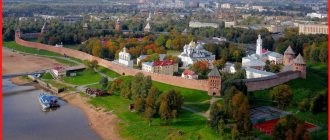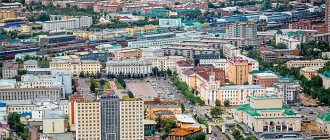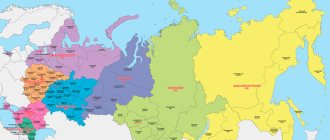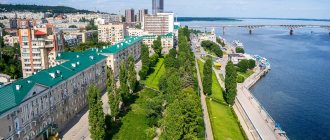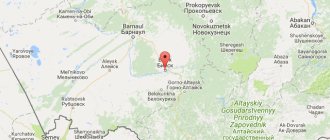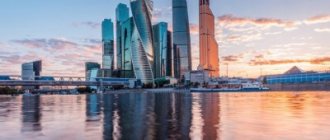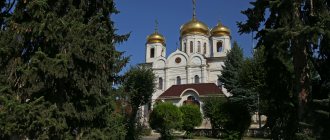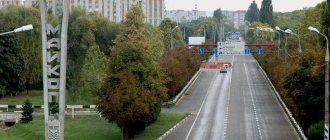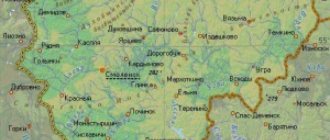The Republic of Mordovia
(m., e.
Mordovia Respublikas
),
Mordovia
(m., e.
Mordoviyas
),
RM
is a republic (state), an equal subject of the Russian Federation. The capital is Saransk (339.5 thousand people, as of January 1, 2002). The population of the Republic of Moldova is 910 thousand people. (as of January 1, 2002). The official languages are Russian and Mordovian languages (Moksha and Erzya).
The Republic of Mordovia is located in the central part of the East European (Russian) Plain, between the Oka and Sura rivers. The area of the Republic of Moldova is 26.1 thousand km². The length from west to east is about 280 km, from north to south – from 55 to 140 km (coordinates 53° 40′ and 55° 15′ N, 42° 12′ and 46° 43′ E) . It borders: in the west - with Ryazan, in the north - with Nizhny Novgorod, in the east - with Ulyanovsk, in the south - with Penza regions, in the northeast - with the Chuvash Republic. The distance from Moscow to Saransk is 642 km. Part of the Volga Federal District.
The Republic of Mordovia is part of a densely populated and well-developed zone of the Russian Federation. The most important railway, pipeline and highway routes pass through the territory of the republic, connecting the European part of Russia with the Urals, and the north with the Volga region. A developed national economic complex with diversified industry and agriculture has been created.
[edit] Government system
The Republic of Mordovia has on its territory all the fullness of state power, with the exception of powers assigned in accordance with the Constitution of Russia to the jurisdiction of the Russian Federation, as well as those that are the subject of joint jurisdiction of the Russian Federation and the Republic of Mordovia in accordance with the Constitution of Russia and the Constitution of the Republic of Mordovia (see Constitutional and legal status Republic of Mordovia).
State power in the Republic of Moldova is exercised on the basis of division into legislative, executive and judicial. The system of government bodies of the Republic of Moldova includes:
- The Head of the Republic of Mordovia is the highest official elected on the basis of universal, equal and direct suffrage by secret ballot for a period of 5 years. Heads the Government of the Republic of Moldova, in agreement with the State Assembly of the Republic of Moldova, appoints the Chairman of the Government, approves its structure;
- The State Assembly of the Republic of Moldova (unicameral) is the highest legislative (representative) body of state power of the Republic of Moldova, elected for 4 years. His jurisdiction includes introducing amendments to the Constitution of the Republic of Moldova, implementing legislative initiatives in the State Duma of the Federal Assembly of the Russian Federation, monitoring the implementation of the legislation of the Russian Federation and the Republic of Moldova, as well as the budget of the Republic of Moldova, exercising other powers assigned by the Constitution of the Republic of Moldova and the laws of the Republic of Moldova;
- The Government of the Republic of Mordovia is the permanent highest executive body of the Republic of Moldova, formed and headed by the Head of the Republic of Moldova, accountable to the State Assembly of the Republic of Moldova. Consists of the chairman, deputy chairman, ministers and other heads of executive bodies of state power of the Republic of Moldova. Develops the budget of the republic and ensures its execution; develops programs for the socio-economic development of the Republic of Moldova; carries out management of the property of the Republic of Moldova and other powers assigned to it by the Constitution of the Republic of Moldova, federal laws, laws of the Republic of Moldova and other regulatory legal acts of the Russian Federation;
- The judicial system of the Republic of Moldova is a link in the unified judicial system of the Russian Federation. Established by the Constitution of the Russian Federation, federal laws, the Constitution of the Republic of Moldova and the laws of the Republic of Moldova.
In cities, towns, rural settlements and other territories of the Republic of Moldova, management is carried out by local government bodies. Local self-government is implemented through various forms of expression of the will of the population (referendums, meetings, gatherings, etc.), elected and other self-government bodies; ensures that the population independently resolves issues of local importance and manages municipal property.
The Republic of Mordovia has its own state symbols: coat of arms, anthem and flag.
In accordance with the Constitution of the Russian Federation and federal laws, territorial structures of federal government bodies operate on the territory of the Republic of Moldova. Coordination of their activities to implement the policy of the President of the Russian Federation in the republic is ensured by the plenipotentiary representative of the President of the Russian Federation in the Volga Federal District and the Chief Federal Inspector for the Republic of Mordovia appointed by him.
Belozerye - what is it and where
The village of Belozerye has been known since the 17th century, when the steppe borderland of the Moscow kingdom was developed by service people, among whom there were many Tatars. They inhabited the so-called Simbirsk serif line - one of the lines of fortifications that was supposed to protect the population of Muscovy from raids by various nomads. Serving Tatars founded a village near a small clean lake. In Rus', lakes with clear spring water were traditionally called white, and the village was called Belozerye. Despite the Russian name, Belozerye remained almost exclusively Tatar for centuries. And now more than 95% of the village’s population are Tatars.
Belozerye is located 30 kilometers from Saransk, the capital of Mordovia, the closest national republic of Russia to Moscow. Tatars make up approximately 5% of Mordovia's population and live compactly in several villages north of Saransk. Belozerye is not at all like the village from the stereotypes - lack of work, abandoned houses with fallen fences and problems with alcohol. Belozerye is prosperous and solid, the houses here are mostly large and strong, and the fences are neat and even. The Tatars of Belozerye turned out to be unusually enterprising, and the prosperity of the village is associated precisely with the business spirit of the local residents.
Belozerye is a prosperous and solid village, the houses here are mostly large and strong, and the fences are neat and even.
[edit] History
On July 16, 1928, the Mordovian Okrug was created as part of the Middle Volga region; on January 10, 1930, it was transformed into the Mordovian Autonomous Region. From December 20, 1934 - Mordovian Autonomous Soviet Socialist Republic, from December 7, 1990 - Mordovian Soviet Socialist Republic, from January 25, 1994 - Republic of Mordovia. The current Constitution of Mordovia was adopted by the Constitutional Assembly of the Republic of Moldova on September 21, 1995. For success in the development of the national economy, science and culture, the Republic of Moldova was awarded 2 Orders of Lenin (1965, 1985), the Order of Friendship of Peoples (1972), and the Order of the October Revolution (1980).
Saransk
History of Saransk
Back in the 1st millennium BC.
e. On the territory of modern Mordovia lived peoples belonging to the Finno-Ugric group - Erzya and Moksha. Traditionally, they are called Mordovians, although the Erzyans and Mokshans themselves identify themselves as independent ethnic groups. They differ in appearance, have their own traditions and language. The name of the city of Saransk comes from the concept “sara”, which, translated from local Finno-Ugric dialects, literally means “swampy, swampy places”. Presumably, the name of the city is associated with the names of the rivers Insar and Saranka. In the 17th century, when a fort began to be built on the site of modern Saransk, they overflowed widely, forming vast swampy spaces. The foundation of the fortress dates back to 1641 and is associated with the name of the governor, Prince Savva Kozlovsky, who supervised the work at the behest of the Moscow Tsar Mikhail Fedorovich, the first Russian ruler from the Romanov dynasty. The Saransk “fortress” was built as one of the most important links in a large defensive line that protected the southern and southeastern lands of the Russian kingdom from the devastating raids of the Crimean and Nogai Tatars. Initially, the fortified fort was inhabited by Cossacks, archers, gunners transferred here from neighboring fortified cities, as well as residents of various nationalities from nearby settlements.
The first railway station of Saransk, built in 1893
Saransk at the beginning of the 20th century
The fortress had an almost square shape, with log towers erected at the corners. The citadel was surrounded by earthen ramparts with a high, pointed palisade dug on top. According to all the rules of fortification of that time, deep ditches stretched from the outer side of the rampart to protect against assault. Along the inner side of the rampart there were also walls with devices for defense. The prison occupied a fairly large territory for those times, the area of which can be compared with the average modern city block.
In 1651, Saransk, around which there were already settlements inhabited by servicemen and townspeople engaged in small trade and crafts, became the administrative center of Saransk district, although it was granted city status only in 1780.
Saransk in the 60s
In 1670, Saransk was captured by the troops of Ataman Mikhail Kharitonov, one of Stepan Razin’s associates. For several months, the city and the district served as a stronghold for peasants and Cossacks who rebelled against the tsarist government. Government troops managed to expel the rebels from the city only after several unsuccessful attempts to storm.
By the beginning of the 18th century, the strategic position of Saransk was reduced to a minimum, and it turned into a city of artisans and traders. The development of commerce was facilitated by the favorable location of the former fort at the intersection of trade routes connecting Astrakhan with Moscow and Kazan with the Crimean Peninsula. Until the end of the 70s, Saransk was ruled by voivodes, the city’s population exceeded 5,500 people, and there were about 700 households.
In 1774, the townspeople greeted Emelyan Pugachev with enthusiasm, believing the rumors that he was Emperor Peter III. The three-day stay of the imaginary king in the city was marked by the execution of a number of nobles, officials, and church servants, as well as the granting of freedom to the peasants and the release of prisoners. After Pugachev left Saransk, tsarist troops entered the city, putting an end to the fleeting freedom of the townspeople.
By the beginning of the 19th century, Saransk belonged to the Penza province. This century was marked by the industrial development of the city and its redevelopment. Iron and brick factories, factories for the production of soap and shag began to operate here, and small businesses developed. In 1893, Saransk joined the cities of the Volga region, through which the Moscow-Kazan Railway line was laid. Residential buildings in Saransk remained wooden. Only a few churches and a number of houses of wealthy merchants and local nobility were built of stone. Three major fires that systematically destroyed wooden buildings did not affect the preference of the majority of citizens to build their homes from wood. Wooden buildings prevailed in the city until the middle of the last century.
Soviet power came to Saransk in 1917. Until 1934, the city had the status of first a district and then a regional center. On December 20, 1934, it became the capital of the Mordovian Autonomous Soviet Socialist Republic. During the Second World War, Saransk factories produced ammunition, uniforms, and food for the army; many institutions were converted into hospitals. In the post-war years, a diversified industry developed in the city, new residential areas were developed, and by the 80s of the twentieth century, Saransk was a developed industrial center.
Since 1991, Saransk has the status of the capital of the Republic of Mordovia - a subject of the Russian Federation. Together with the whole country, it survived the controversial 90s, when, unable to withstand market competition, many city-forming enterprises closed. At the beginning of the new century, Saransk began to regain its position as a major regional center. Recently, the city's infrastructure has been significantly modernized, which was also facilitated by the hosting of the FIFA World Cup matches here in 2022. In preparation for this significant event, an international-class stadium “Mordovia Arena”, new roads and transport interchanges, hotels were built, and finally, after a large-scale and lengthy reconstruction, Saransk Airport reopened its air gates.
Mordovia Arena Stadium
Geography and climate
Saransk is located in the forest-steppe zone of the central part of the floodplain of the Insar River, which is part of the vast territory of the Volga basin. Within the city limits of Saransk, the Saranka River flows into Insar on the left bank, and the Tavla River flows from the right bank.
Saransk from satellite
The city's topography is determined by its location on the Volga Upland. A characteristic feature of the landscape is the asymmetry of the slopes on which the urban areas are located. The southern and western hills are steeper, the northern and eastern ones are almost flat. Close to the southwestern and northwestern outskirts of the city there are forests, where mainly oaks, maples, ash trees, and elms grow. The undergrowth is dominated by rowan, bird cherry, euonymus, and hazel. The banks of the Insar River and its tributaries, as well as ravines and ravines, are covered with meadow grasses.
From the nearest regional center - Penza - Saransk is separated by 128 km, from the capital of the Russian Federation - 500 km in a straight line and 642 km along the highway. Local time corresponds to Moscow.
The climate of Saransk is characterized as moderate continental. Winters here are quite cold, and summers are hot. In winter, it is usually cloudy, strong winds often blow, and snowstorms are common. The average air temperature is about –15…–10 °C. Sometimes there are frosts of 30 degrees, but there are also thaws. The coldest month is January.
Spring comes to Saransk at the end of March – beginning of April. Early spring is characterized by the return of cold weather and frosts. At the end of April – beginning of May it is already warm, the daytime temperature exceeds +20 °C. Dry winds are observed at this time.
In summer the air warms up to +25…+30 °C. The hottest month is July, which is also the rainiest, although thunderstorms, showers, and squalls are also possible in June and August. Unfavorable phenomena of the summer season also include droughts, hot winds, and abnormally high temperatures, when the thermometer records a temperature exceeding +35 °C.
Real autumn comes into its own from mid-September. If in the first weeks of the month the daytime temperature is still maintained at +20...+22 °C, then at the end of the month it drops to +10...+13 °C. By the end of October frosts begin. In the second ten days of November it becomes winter-like cold, the temperature drops below 0 °C, snow falls, and rivers begin to become covered with ice.
Mordovian State University named after N.P. Ogarev main building
City districts and population
Administratively, Saransk is divided into three districts: Leninsky, Oktyabrsky and Proletarsky. However, townspeople do not use these names in everyday life. Other names of microdistricts and residential areas have long taken root here, which are even used in the names of stops on transport routes: "), "Svetotehstroy", "Elevator", "South-West", "Khimmash" (old and new), "Nizy", “Ambassador”, “TC-2”, “Gypsy”, “Promzone”. This unofficial division of the city corresponds to its existing historical development.
About 320,000 people live in Saransk, almost two-thirds of them are Russian. Erzyans and Mokshans are the second largest group, there are about 70,000 people. There are also a lot of Tatars here – more than 16,000 people.
Walk around Saransk
There are not too many historical attractions in Saransk, but the city deserves to get to know it better. You can start a walk around the capital of Mordovia from the place where Bolshevistskaya street intersects with Sovetskaya. Here you will see one of the main city attractions - the Cathedral in honor of the righteous warrior Fyodor Ushakov. The majestic blue and white temple, built in the neo-Byzantine style, seems to float above the city, sparkling with golden domes and striking with its grandiose size.
Cathedral in honor of the righteous warrior Fyodor Ushakov
Service in the cathedral
The cathedral was erected in 2006 and consecrated by Patriarch Alexy II. The height of its dome reaches 60 m, and it can accommodate more than 3,000 people. This temple is the largest in Mordovia and one of the largest in the entire Volga region. The belfries of the temple are crowned with 12 bells, specially cast using ancient technologies in the Yaroslavl region. The main bell weighs 6 tons, the next one weighs 3 tons, then 1.5 tons, etc. If you climb to the first level of the roof, to a height of 40 m, a beautiful panorama of Saransk will open before you.
Monument to Admiral Fyodor Ushakov in Saransk
The bright, spacious interior of the temple is richly decorated and impresses with its sacred beauty. After sunset, the Cathedral is spectacularly illuminated and looks no less magnificent than during the day.
Orthodox fairs are often held on the elegant square in front of the cathedral. There is a monument to Fyodor Ushakov here - a four-meter sculpture made of bronze. The legendary admiral, who did not lose a single battle, spent the last years of his life in Mordovia, doing charity work. He was canonized in 2001. Also next to the temple there is a monument to Patriarch Nikon - the only one in Russia.
A short walk from the cathedral is the Church of St. John the Evangelist. Built in 1693, it is not only the oldest temple in Saransk, but also the oldest surviving building in Mordovia. From 1991 until the time the cathedral was erected in the name of Fyodor Ushakov, this ancient church had the status of a cathedral. The five-domed temple looks elegant and strict, reminiscent of churches in the Moscow region and Pskov.
Church of St. John the Evangelist in Saransk
Soviet Square in Saransk
Very close to the Cathedral and the Church of St. John the Evangelist there is a recreation park named after. A.S. Pushkin is a favorite place of the townspeople. Its history begins in the 19th century, when a city garden was laid out on this site. Before the revolution, amateur theater actors performed here, free cinema operated, and folk festivals took place. In 1935, the garden area was expanded five times, planting it with greenery and flowers. Over time, a summer theater, a dance floor, a cafe, and a new summer cinema appeared here. Today the park covers an area of 40 hectares. It was landscaped taking into account new trends in the art of landscape design. Here the system of reservoirs was updated, nice sculptures and fountains were installed, lawns and flower beds with original flower arrangements were laid out. The park has many attractions, including a Ferris wheel, free playgrounds, and a boat and catamaran rental station on the river bank. The zoo located here is home to many animals, including monkeys, pumas, tigers, and lions.
There are cafes in the park; stalls sell pies, sausage rolls, ice cream, cotton candy, water, and kvass. In general, you can have a great time here for the whole day, having about 1,500 rubles with you for entertainment and snacks.
Recreation Park named after. A. S. Pushkin in Saransk
Near Pushkin Park, take a look at the beautiful, cozy Church of the Assumption of the Blessed Virgin Mary, built in 1734. At the beginning of the 19th century it was rebuilt in the classicist style. In Soviet times it did not function, but in the 80s of the last century the church was restored, and in the 90s it was returned to the fold of the Orthodox Church.
The oldest temples in Saransk include the Trinity Church, built in 1701. True, since then it has been rebuilt several times. This temple is a slender, miniature white building of classical shape with dark green roofs and two small gilded domes. The church is located approximately a kilometer east of the Cathedral, on Volodarsky Street.
Assumption Church in Saransk
Trinity Church in Saransk
In the eastern part of the city, across the Insar River, in the Khimmash area, there is another historical landmark - St. Nicholas Church. Built at the end of the 19th century, it is a majestic five-domed structure. The temple is made of red brick, which gives it a special color and solemnity.
St. Nicholas Church
Pugachev tent in Saransk
In the very center of Saransk, on Moskovskaya Street, there is a memorable place associated with Emelyan Pugachev’s stay in the city. This is the so-called Pugachev tent, which is a small stone house. According to legend, from his porch heralds read out manifestos issued by the leader of the peasant uprising, who proclaimed himself tsar.
Once on Moskovskaya Street, take a look at the Mordovian Republican Museum of Local Lore. It is located in the beautiful building of the Nizhnekazan (Three Saints) Church, which is an architectural monument of the 17th century. The museum has three departments: historical, modern, and nature of Mordovia.
The entrance ticket costs 80 rubles for adults, 20 rubles for children. Guide services must be paid separately.
Monument to Pushkin in Saransk
Mordovian Republican Museum of Local Lore
Moskovskaya Street in Saransk also includes Fountain Descent. There are three cascading fountains, equidistant from each other. On the descent there is a monument to Pushkin, which is one of the calling cards of the city.
Museum of Fine Arts. Stepan Erzya
Nearby, on Kommunisticheskaya Street, is one of the most famous museums in Mordovia - the Museum of Fine Arts. Stepan Erzya. This name belongs to a wonderful Mordovian sculptor; the museum has a large collection of his works. Stepan Erzya, a master who created sculptures from wood, reinforced concrete, and marble, lived for a long time in Europe and South America, but then returned to his homeland with his creations. His expressive Art Nouveau works make a lasting impression. No less interesting are the paintings of the famous portrait painters Ivan Makarov and Fedot Sychkov. In the hall of Russian painting you can see paintings by Aivazovsky, Shishkin, Savrasov. The museum has professional lighting installed, and you get the feeling that an inner light emanates from the paintings. Visit the ground floor, where small sculptures, samples of Khokhloma, Zhostovo dishes, and crystal are collected.
This museum has several branches, the closest is the Museum of Mordovian Folk Culture, located on Sovetskaya Street. The Erzya House-Museum and the Sychkov House-Museum are located outside Saransk, in the villages of Baevo and Kochelaevo, respectively.
Entrance to the main building of the museum costs 150 rubles.
St. John the Theologian Monastery
A 5 km drive from Saransk, in the village of Makarovka, there is a place that every guest of the city must visit. This is the St. John the Theologian Monastery. The first buildings appeared here at the beginning of the 18th century. These were the cold Church of St. Nicholas the Theologian and the warm Church of St. Michael the Archangel with it, built by the landowner Makar Polyansky. However, neither the temple nor the church were parish, but served for two centuries as family sanctuaries of the Polyansky family, which owned the local lands.
John the Theologian Monastery in Makarovka
Over time, the Polyanskys built almshouses nearby, first for men, then for women, and surrounded the territory with a wall, according to monastic custom, but for a number of reasons this place did not become a monastery. At the beginning of the 19th century, the Church of the Icon of the Sign of the Mother of God was also built here. Over time, a whole park and architectural complex with temples, bell towers, a park, ponds and bridges across them was formed here. At the beginning of the twentieth century, the Makarovsky Pogost, as it was then called, came under the jurisdiction of the church parish. The peasant community could not adequately support it, and by the 1917 revolution everything here had fallen into disrepair. In the 60s, the complex began to be restored, in the hope of creating something like an open-air museum with a recreation area. The plans did not come true, and in 1987 local residents managed to demand from Patriarch Pimen the St. John the Theological Church under the jurisdiction of the parish. Over the following years, the churchyard was gradually transferred to the believers. Finally, in 1994, it turned into a real monastery: with the blessing of Patriarch Alexy II, the St. John the Theological Monastery was opened here.
Today the churches of the monastery are open to believers and pilgrims. There is a pilgrimage center, a refectory, and a hotel here. Ordinary tourists will be curious to see beautiful religious buildings with a rich history and take a walk through the huge monastery park.
Entertainment
There are 3 theaters in Saransk - Musical, Dramatic, Mordovian National; There are many cinemas, most of which are equipped with modern technology. The whole family can relax in the entertainment center. It is divided into several zones, in which numerous attractions are designed for guests of all ages, from children 2-4 years old to adults who like to have a fun and active time.
Yaushev Opera and Ballet Theater in Saransk
If you want to play billiards, go to the Mordovia sports complex or the Formula C sports and entertainment complex, which has 8 Russian billiard tables, in addition to having 2 pools and 1 nuker. The Rado entertainment complex offers bowling and also houses the Iceberg nightclub.
Saransk at night
The nightclub is also part of the Kinomax-Pobeda entertainment complex, located in the very center of Saransk, on Lenin Avenue. It is called “Horovod” and attracts with its large hall for 220 people, a spacious dance floor, a restaurant with European and Japanese cuisine, and a contact bar. Professional sound and lighting equipment is installed here, and parties are often hosted by famous DJs.
The Chateau nightclub, part of the Polar Bear entertainment complex, is popular in Saransk. Here guests will find discos, performances by fashionable DJs, and a go-go dance support group. The Chateau hosts themed parties and costume shows.
The Arbat nightclub, which opened in 2016, quickly gained fame and today is one of the popular nightlife establishments in Saransk.
Souvenirs
Monument “Airplane” in Saransk
You will not go wrong if you purchase any product with hand embroidery as a souvenir of your trip to Saransk. This type of needlework has always occupied a special place in the decorative and applied arts of the Mordovians. In traditional patterns, the predominant ornamental motifs are geometric shapes, classic colors are red, black and white, but blue, yellow, and green colors are also found. Beads are often added to the thread. In stores in Saransk you can buy hand-embroidered clothes, as well as elegant tablecloths, towels, and bed linen. Mordovian ornament is admired both in Russia and abroad. By the way, back in the 19th century, at the World Exhibition in Paris, the embroidered national costume of an Ezrian woman received a Gold Medal.
Among other original Mordovian souvenirs: carved wooden figurines - famous crafts of Tavlinsky masters, Urusov felt boots, baskets, boxes, products woven from wicker and birch bark, Mordovian dolls.
Alcoholic products from Mordovia are also in demand among tourists. The most popular brands are “Samovar” and “Chistye Rosy”. As a delicious souvenir from Saransk, you can bring wonderful natural sausages and cheeses from local factories.
Kitchen
Mordovian cuisine, on the one hand, is close to traditional European, and on the other, it is not without a Finno-Ugric flavor. You can verify this by visiting the Mordovian Compound restaurant of national cuisine in Saransk. Here guests enjoy the original, rustic interior and cozy atmosphere. The chefs cook very tasty game, grilled duck breast, dumplings with venison, soup in bread, wheat pancakes, dumplings with cottage cheese, cherries and, of course, the national Mordovian dish - “bear's paw”. In the restaurant you can taste Mordovian moonshine (chenke). There is a play area for children.
Monument “Forever with Russia” in Saransk
Another restaurant where you can taste traditional Mordovian dishes is “The Eighth Wonder of the World”. However, the menu here also offers a wide range of dishes from European and Japanese cuisine. In the same building, on the ground floor, there is a nice art cafe “Arbuzov”. They make wonderful ice cream and cocktails here. Regulars claim that they serve the best Greek salad in the city. You can also stop by the cafe for a business lunch. It will cost 200 rubles per person.
Also popular are establishments with original cuisine - the Argo restaurant and the Panorama restaurant, which specializes in preparing the most famous dishes of European cuisine.
There are many cafes and pancake shops in Saransk. Thus, the Boulevard cafe is a pleasant place to relax in the summer, when there is a veranda where you can play billiards. In the “Village House” - a cozy pancake house located on the territory of the park named after. Pushkin, it’s interesting to visit in winter, when they serve hot chocolate and herbal tea. However, there is always a wide selection of pancakes, delicious salads and home-cooked dishes here. The Rozmarin cafe with its extraordinary interior, mixed cuisine and always fresh beer is popular among young people. The oriental cuisine cafe “Chaikhana” serves very tasty food. There is always a kebab for every taste, lagman with beef or lamb, and aromatic shurpa.
Where to stay
There is only one five-star hotel in Saransk - Four Points by Sheraton Saransk. It is located in the historical part of the city, near the Mordovia Arena stadium and a quarter of an hour’s drive from the airport. This stylish hotel has a fitness center, indoor swimming pool, Finnish sauna, spa, restaurant, panoramic terrace. The rooms are spacious and comfortable. The cost of living is from 3,500 rubles per day.
Reasonably expensive ones include the four-star hotels Mercure Saransk Center, Admiral, Meridian, as well as the hotel of the Olympic reserve athletics school, located a 15-minute drive from the city center, near a forest and park area. Accommodation in a double room in 4* hotels costs from 3,200 rubles per day.
In the city you can stay in one of the three-star hotels. In this case, you will pay from 900 rubles per day for a room.
As an alternative to hotels in Saransk, there are hostels and motels. So, in the very center of the city, a 5-minute walk from the railway station, there is the Uyut hostel (from 400 rubles per night). A good option for accommodation is the cafe-motel “Golden Valley” or the motel “Prichal”, where they prepare delicious home-cooked food.
Booking.com
Transport
City transport is represented by buses, trolleybuses and minibuses, which reliably provide communication between all areas of the city. For the Football World Cup, the municipal transport fleet was updated and replenished with 50 buses and 30 low-floor trolleybuses.
When moving around Saransk, a significant part of the townspeople opt for minibuses, as they consider traveling on them the fastest way to travel. During rush hours, minibuses in Saransk depart from the stop every 2-3 minutes.
Taxi services in the city are provided by about 20 companies.
Trolleybus on Pobeda Street in Saransk
How to get there
Saransk Airport
You can get to Saransk by any type of transport: the Kuibyshevskaya railway line runs through the city, as well as several highways. The Saransk airport, which opened after reconstruction, receives regular flights from Moscow and St. Petersburg. You can fly from the capital to Saransk in an hour. In the summer months, flights between Saransk and Sochi open.
Saransk railway station is located in the city center. The main building, commissioned in 2009, looks very impressive and deservedly claims to be one of the city’s landmarks. Trains going to Kazan, Sverdlovsk, Nizhny Novgorod, Kirov, Vorkuta, Penza, Astrakhan pass through the Saransk station. It runs daily between Moscow and Saransk.
The bus station is located near the central area, on Polezhaeva Street. From here buses depart on 224 routes - suburban and intercity. A bus service connects Saransk with Moscow and the cities of the Moscow region, the cities of Ryazan, Samara, Saratov, Penza, Nizhny Novgorod, Ulyanovsk, Volgograd regions, and settlements of the Republic of Chuvashia.
Calendar of low prices for air tickets
[edit] Administrative-territorial division
The Republic of Mordovia includes one city of republican subordination (Saransk and 22 municipal districts:
- Ardatovsky municipal district, district center - Ardatov;
- Atyuryevsky municipal district, district center - village. Atyurevo;
- Atyashevsky municipal district, district center - village. Atyashevo;
- Bolshebereznikovsky municipal district, district center - village. Bolshie Berezniki;
- Bolsheignatovsky municipal district, district center - village. Bolshoye Ignatovo;
- Dubyonsky municipal district, district center - village. Dubyonki;
- Elnikovsky municipal district, district center - village. Elniki;
- Zubovo-Polyansky municipal district, district center - village. Zubova Polyana;
- Insar municipal district, district center - the city of Insar;
- Ichalkovsky municipal district, district center - village. Kemlya;
- Kadoshkinsky municipal district, district center - village. Kadoshkino;
- Kovylkino municipal district, district center - Kovylkino;
- Kochkurovsky municipal district, district center - village. Kochkurovo;
- Krasnoslobodsky municipal district, district center - Krasnoslobodsk;
- Lyambirsky municipal district, district center - village. Lambir;
- Romodanovsky municipal district, district center - village. Romodanovo;
- Ruzaevsky municipal district, district center - Ruzaevka;
- Staroshaigovsky municipal district, district center - village. Old Shaigovo;
- Temnikovsky municipal district, district center - Temnikov;
- Tengushevsky municipal district, district center - village. Tengushevo;
- Torbeevsky municipal district, district center - village. Torbeevo;
- Chamzinsky municipal district, district center - village. Chamzinka.
The largest number of mosques per capita in Russia
There are eight mosques in Belozerye, and this is the largest number of mosques per capita in Russia - one for every 360 people. Neither Tatarstan nor the North Caucasus has such a concentration. The architecture of the mosques is typically Tatar - they are mostly brick buildings without unnecessary decoration with a hipped roof and a low minaret. The first of the modern mosques was built during the USSR, in 1989. And the newest one, built in 2013, is the Juma mosque (that is, the “Friday” mosque, the main one in the village) - with its slender minaret towers and lancet windows, it is a bit reminiscent of a Gothic cathedral.
Belozerye has the highest concentration of mosques per capita in Russia - one for every 360 people
Mosques are located on almost every street, so that any resident can walk to the nearest one in a few minutes. Most local residents perform five daily prayers and observe other pillars of Islam. Men wear beards and skullcaps, and all women cover their heads with a scarf. Because of this, there were even scandals related to the ban on wearing hijabs in a local school. Belozerye Muslims are Sunnis of the Hanafi madhhab. There are four madhhabs: Maliki, Hanbali, Shafi'i and Hanafi. The last two are common in Russia.
One of the reasons for the high level of religiosity is that in Soviet times the Belozersk community continued to live according to Muslim canons. Residents performed namaz and celebrated the religious holidays of Kurban Bayram and Eid al-Adha, which was even recorded in official documents. And throughout the Soviet period there were mullahs in the village.
You can read more about the development of Islam and the various movements that led to conflicts within the Belozerye community in the article by Ilnur Minnulin, a researcher at the Kazan Institute of History.
I arrived in the village between prayers, and the Juma mosque was closed. But there was still some activity around it - local boys were racing around the square on motorcycles and at the same time looking at me with undisguised curiosity. Guests in Belozerye are treated with suspicion, and sometimes it takes quite funny forms. Local men periodically stopped me and asked who I was and where I was from. When they stopped me again, one of the questions was whether I was a Tatar or at least a Muslim. My negative answer caused sincere surprise: “Why not?” In the minds of local residents, either Muslims or journalists can be interested in their village, which usually ends in reports that local residents do not really like.
Local youth ride motorcycles around the village from an early age
[edit] Population
Main article
:
Population of the Republic of Mordovia
Mordovians (Moksha, Erzya), Russians, Tatars, Ukrainians, Belarusians and representatives of other nationalities live on the territory of Mordovia.
In the 20th century The Republic of Mordovia, like Russia as a whole, is characterized by wave-like dynamics of the total population size and density. The maximum population was recorded in 1929 - 1,369.9 thousand people. Reduction of the network of rural settlements in the 1950-1980s. served as a catalyst for depopulation. A slight increase in its numbers was noted in the post-war period. In 1969 it amounted to 1,040 thousand people. Since 1970, the population of the republic has been constantly declining. This is due to significant natural decline and negative balance of population migration.
Rivers
Multiple river channels pass through the territory of Mordovia. If you look at the map of the republic, you can see how densely the region is covered with all kinds of waterways.
The largest river that flows through the region is Moksha. The river begins its flow in the neighboring Penza region and through Mordovia flows into the Oka already on the territory of the Ryazan region.
The Sura River is considered one of the most beautiful rivers flowing along the Volga Upland. There are often tourist routes, kayaking and kayaking, recreation centers and children's health camps have been built here.
And the deepest river in the region is considered to be the Alatyr, which is very different in its landscape from other waterways in the region. In some places the width of this river reaches 5 km.
[edit] Nature
Main article
:
Nature of the Republic of Mordovia
Coniferous-deciduous and broad-leaved forests, shrub and meadow steppes are widespread on the territory of Mordovia. The flora includes more than 1,230 species of vascular plants from 495 genera and 109 families. Of these, 4 are species of clubmosses, 8 are horsetails, 18 are ferns, 3 are gymnosperms, and the rest are flowering plants. Herbaceous plants predominate; the number of tree and shrub species is small. The main forest-forming species: pine, spruce, larch, English oak, ash, sycamore maple, elm, warty and downy birch, alder, small-leaved linden, black poplar.
In Mordovia, 63 species of mammals (of which 35 are rare), 267 species of birds (70 rare), and 44 species of fish live in the reservoirs of the republic. The world of insects is rich (more than 1,000 species), but the diversity of reptiles and amphibians is small. The fauna consists of representatives of the forest fauna (elk, wild boar, lynx, marten, white hare, wood grouse, hazel grouse, woodpeckers, blackbirds, tits) and, to a lesser extent, steppe fauna (speckled gopher, steppe mole rat, common mole rat, great jerboa).
Geographical location and climatic conditions of Mordovia
Mordovia lies on a plain with a double name - Russian or East European.
More than 13 rivers flow through the territory. But the location itself is in the Volga River basin, between Oka and Sura. The online map of the region allows you to see the borders and areas of Mordovia, the length of which from north to south is 100 km, from west to east – 300. It borders on different regions:
- North – Nizhny Novgorod;
- South – Penza;
- Northeast – Chuvashia;
- South-east - Ulyanovsk;
- West – Ryazan region.
The climate is conducive to the cultivation of agricultural crops and is temperate continental. Given the flat nature of the landscape on which the republic is located, it is exposed to winds from different directions. Therefore, the temperature regime is not constant and can vary:
- In winter – from -1 to -20 degrees;
- In summer – from +15 to +27.
This climate is favorable for growing crops, raising livestock and poultry. Therefore, the region has developed livestock farming, poultry farming, planting of grains, corn, etc., and many agricultural enterprises.
Climate Features
The republic is located in temperate latitudes, so all four seasons are clearly expressed and clearly follow each other. The remoteness from the oceans and seas also makes its contribution, forming the continental type of climate of Mordovia, with large annual temperature amplitudes.
The republic has a relatively hot summer, which lasts exactly according to the calendar: starting in June and ending in the last days of August. July is the hottest month, when temperatures reach +26-27 °C. During this period, western and northern air masses predominate. In summer, thunderstorms, hot winds, squalls and droughts often occur.
The coldest month of the year is January with an average temperature of -11 °C. Winters in Mordovia are cloudy and frosty. But extreme frosts do not last long and temperatures rarely drop below -15 °C. The absolute minimum ever recorded in the republic was -47 °C. In winter, air humidity is much higher than in summer. Typical phenomena in the cold season are fog, ice, frost, snowstorms and strong winds.
Islamic fundamentalism
Over the last decade, the police and the FSB have been actively interested in Belozerye on extremist issues. Almost all media reports portray Belozerye as a hotbed of radical Islam and almost the main supplier of militants to Syria. Naturally, after such materials, the attitude towards journalists here is more than restrained. The List of Active Terrorists and Extremists posted on the website of the Federal Service for Financial Monitoring includes 33 village residents (1 in 88 people), with 50 names in total from Mordovia. In terms of the concentration of people recognized as extremists, Belozerye can rival only the Dagestan village of Gimry (71 people on the list), known as the homeland of many jihadists. A side effect of this is that Belozersk mosques open only for prayer. The rest of the time they are locked for fear that someone might find extremist literature, which would serve as a reason for another case. Lists of such literature are constantly updated, and no one knows which book will appear there next time.
Mosques are located on almost every street, so that any resident can walk to the nearest one in a few minutes
Ramadan and hospitality
During my visit to Belozerye there was one more additional factor - the height of the holy month of Ramadan. From dawn to dusk, observant Muslims do not eat and try not to drink water. But even this did not stop the Belozersk people from showing hospitality. Despite some wariness, local resident Hafiz, interrupting his work in the garden, invited me to his home. He quickly ordered the table to be set, and literally ten minutes later his wife brought cheese, bread, sweets and tea. It was doubly touching because the hungry hosts humbly watched my dinner. After talking a little about life in the village, about Hafiz’s family (he has four children and, inshallah, there will be more), I went, on his recommendation, to one of the mosques.
There, a large group of men were preparing a meal in special cauldrons for Iftar - the evening breaking of the fast (meal during the month of Ramadan). That day it was aromatic pilaf, the smells of which spread throughout the village. I was invited to watch the process and at the same time told about the basic tenets of Islam. After sunset, a cheerful feast began, and local children delivered pilaf to all houses on their motorcycles. Another ordinary day passed in one unusual village.
Men prepare pilaf for evening breaking of fast
What is the Saratov region number?
CAR CODES OF RUSSIA REGIONS
| Russian region number | Region of the Russian Federation | Capital |
| 61 regions | Rostov region | Rostov |
| Region 62 | Ryazan Oblast | Ryazan |
| Region 63 | Samara Region | Samara |
| Region 64 | Saratov region | Saratov |
Interesting materials:
How to remove FPS limit in Windows 10? How to remove Windows 10 speed limit? How to remove the 60 fps limit in games on Windows 10? How to remove restricted Wifi access in Windows 7? How to remove the search box in Windows 10? How to remove the search bar in Windows 10? How to remove the Windows 10 start bar? How to remove the panel at the bottom of Windows 10? How to remove the taskbar in Windows 10 games? How to hide the taskbar in full screen mode in Windows 10?
